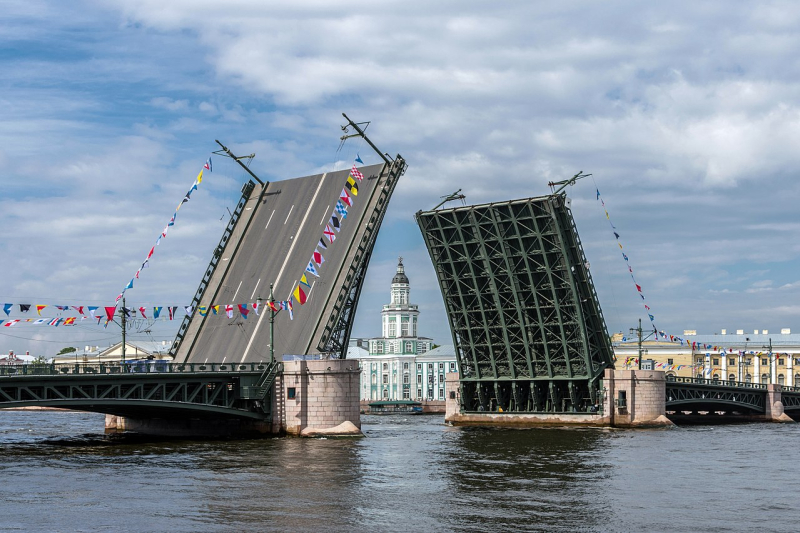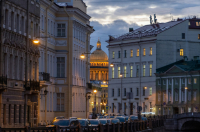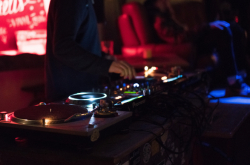This may sound strange, but according to St. Petersburg’s initial planning, there shouldn’t have been any bridges in the city: Peter the First, its founder, wanted it to become the “Northern Venice”, and banned bridges so that citizens would use boats instead. As great as that may sound, the idea never really worked out, and some hundred years after Peter’s death, the ban was lifted; since then, over 300 magnificent bridges have spanned Neva and its arms, having become one of the city’s major attractions. Neva, however, never ceased to be an important waterway, so in truth, the building of bascule bridges was more of a rational rather than an aesthetic solution.
In any case, the start of the navigational period in St. Petersburg has always symbolized the real beginning of summer; every night, people gather to watch huge metal arches slowly rise into the sky to make way for ships leaving for the Baltic Sea. However, there’s one thing that some of St. Petersburg’s guests get to learn the hard way: the bridges over Neva are not just the city’s most famous landmark, but also the source of a peculiar problem. From May to September, “being late for the bridges” can get you stranded on one side of the Neva river with almost no option of crossing it until dawn; this issue has been around long enough to become an essential part of the local lifestyle and even be reflected in the popular culture.
So, when setting out to do some bridge watching, there are a few things that you’ll want to consider. First of all, be sure to plan your time - the first bridges start opening at around 1:20 am, which is way past the time the subway closes; a good idea would be deciding on some place, like a bar, where you’ll spend time before (or after) that. If you don’t intend to stay up until the early morning, be sure to check with the bridge opening timetable; note that for some bridges, there’s a period of time when traffic is restored for about half an hour, which can be a real lifesaver. Mind that you can also cross the river via the Bolshoy Obukhovsky Bridge, the only bridge across Neva that is not bascule, though that would mean making a really long detour.
Another thing is that the whole process of a bridge opening takes only about several minutes, so do think about combining bridge watching with some other kind of activity. For one, making it a night-long bicycle ride is my personal choice, as this lets you watch most of St. Petersburg’s bascule bridges in one go (doing that on foot would mean going for a 20-kilometer trek along the city’s embankments). If you’re still set on having a stroll, you might want to decide on your route in advance: the nighttime scenery of St. Petersburg is truly magnificent, and there really are lots of beautiful spots to appreciate. By the way, here are some places that are definitely a must-see:
Annunciation Bridge - also known as the Lieutenant Schmidt Bridge (it is still written on it in large gilded letters, which can be a bit confusing), is the first permanent bridge built across the Neva river, and the also the first to open. Despite several reconstructions and having much of its decor removed over the years, it still boasts the title of one of St. Petersburg’s most beautiful bridges. Being the closest to Neva’s estuary, it is a great spot to start your bridgewatching tour from.
Spit of Vasilievsky Island - this eastmost part of Vasilievsky Island overlooking the Peter and Paul Fortress features one of St. Petersburg's most beautiful architectural ensembles. Located just between the Palace Bridge and the Exchange Bridge, this spot is just ideal for bridge watching. Note that just a 20 minute walk from the spit, near the Tuchkov Bridge, there’s a pedestrian tunnel to the Petrogradsky Island.
Palace Embankment - probably the most popular bridge watching spot; it is the view of the Palace Bridge from the Palace Embankment that is usually featured on postcards, calendars, and other St. Petersburg memorabilia. Also, it is quite close to the city’s nightlife districts, which is great if you suddenly have a change of plans.
Peter the Great Bridge - located farther from the city center in the proximity of the Smolny Convent, this bridge is very different from others in both its appearance and surroundings. The place gets really tranquil at night, and has a totally unique atmosphere.
For our final advice, please do remember that though the weather is usually quite warm in the beginning of summer, it’s still St. Petersburg weather, which can be highly unpredictable. Getting ill in early summer would be a great loss, so be sure to bring some warm clothes just in case!
Hope we’ve been helpful! Yours truly, ITMO.NEWS.




